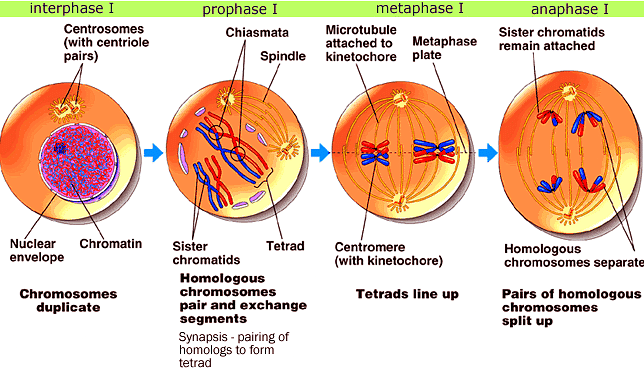MCAT Exam > MCAT Notes > Biology for MCAT > Meiosis: Cellular Division
Meiosis: Cellular Division | Biology for MCAT PDF Download
Introduction
Cell division is a fundamental process in biology, essential for growth, development, and tissue maintenance. While mitosis is responsible for most cellular divisions, there exists a specialized form of cell division called meiosis. Unlike mitosis, which produces genetically identical daughter cells, meiosis serves a distinct purpose in the human body: the production of gametes, or sex cells (sperm and eggs). This intricate process ensures that the resulting gametes possess exactly half the number of chromosomes as the parent cell, leading to genetic diversity in offspring. In this article, we will delve into the fascinating world of meiosis, exploring the mechanisms by which it reduces chromosome number and generates genetic variation.
I. Phases of Meiosis
Meiosis shares similarities with mitosis in terms of stages and strategies employed for chromosome organization and separation. However, meiosis involves a more complex task, necessitating the separation of not only sister chromatids but also homologous chromosomes received from each parent. The process of meiosis consists of two successive divisions: meiosis I and meiosis II, which together result in the production of four haploid gametes.
1. Meiosis I: The Journey Begins
- Before entering meiosis I, a cell goes through interphase, a preparatory phase similar to mitosis. Prophase I marks the beginning of meiosis I, distinguished by unique characteristics not seen in mitosis. During this phase, chromosomes condense and pair up with their homologues, aligning along their entire length. Crossing over occurs, where DNA segments between homologous chromosomes are exchanged, resulting in the formation of remixed chromosomes with distinct combinations of genetic material. The synaptonemal complex, a protein structure, facilitates this process, holding the homologues together. Chiasmata, visible as cross-shaped structures, keep the homologues connected even after the synaptonemal complex breaks down.
- Following crossing over, the spindle apparatus captures and aligns chromosomes at the metaphase plate, akin to mitosis. However, in meiosis I, homologue pairs, rather than individual chromosomes, line up for separation. The orientation of each pair is random, contributing to the formation of gametes with diverse sets of homologues. In anaphase I, homologous chromosomes are pulled apart and move to opposite ends of the cell. Sister chromatids, however, remain attached.
- Telophase I concludes meiosis I, with chromosomes reaching opposite poles of the cell. At this stage, cytokinesis usually occurs, resulting in the formation of two haploid daughter cells. Some organisms may skip the decondensation of chromosomes and reformation of the nuclear membrane since meiosis II follows soon after.

2. Meiosis II: Mitosis for Haploid Cells
- Meiosis II is a simplified and shorter process compared to meiosis I, resembling mitosis. The cells entering meiosis II are haploid, containing one chromosome from each homologue pair but still consisting of two sister chromatids. The goal of meiosis II is to separate the sister chromatids, resulting in non-duplicated haploid cells.
- Prophase II initiates with chromosome condensation, nuclear envelope breakdown, and the movement of centrosomes apart. The spindle apparatus forms, capturing sister chromatids via microtubules from opposite spindle poles. Metaphase II aligns individual chromosomes along the metaphase plate, while anaphase II pulls sister chromatids apart, propelling them towards opposite poles of the cell.
- Telophase II marks the final stage of meiosis, characterized by the formation of nuclear membranes around each set of chromosomes and their subsequent decondensation. Cytokinesis follows, dividing the chromosome sets into new cells. Ultimately, meiosis produces four haploid cells, each containing a single chromatid. In humans, these cells develop into sperm or egg cells, carrying the potential for genetic recombination.

II. Unveiling Genetic Diversity
The gametes generated through meiosis are haploid; however, they are not genetically identical. Even with a minimal number of chromosomes, genetic diversity is achieved through two main mechanisms: crossing over and random orientation of homologue pairs.
- Crossing Over: Shuffling the Genetic Deck - Crossing over, a crucial event during meiosis, occurs when homologous chromosomes exchange genetic material. The precise points at which crossovers occur are selected randomly, ensuring unique combinations of alleles in each cell undergoing meiosis. The formation of chiasmata, visible as cross-shaped structures, facilitates the maintenance of connections between homologous chromosomes after the breakdown of the synaptonemal complex. Multiple crossovers can occur for each homologue pair, resulting in an extensive reshuffling of genetic information.
- Random Orientation of Homologue Pairs: A Genetic Lottery - Metaphase I presents an opportunity for further genetic diversity through the random orientation of homologue pairs. As the homologous chromosomes line up at the metaphase plate, their orientation is arbitrary. This randomness allows for the production of gametes with distinct assortments of homologous chromosomes. The chance alignment of chromosomes during metaphase I creates a genetic lottery, contributing to the unique genetic composition of each gamete.
Conclusion
Meiosis, the specialized form of cell division responsible for generating gametes, plays a crucial role in sexual reproduction. By reducing chromosome number by half and introducing genetic diversity, meiosis ensures the continuity of life with unique individuals in each generation. The intricacies of meiosis, from crossing over to the random assortment of homologous chromosomes, unlock the endless possibilities of genetic variation. Understanding the mechanisms underlying meiosis enriches our knowledge of the fundamental processes shaping life itself.
The document Meiosis: Cellular Division | Biology for MCAT is a part of the MCAT Course Biology for MCAT.
All you need of MCAT at this link: MCAT
|
233 videos|16 docs
|
Related Searches























